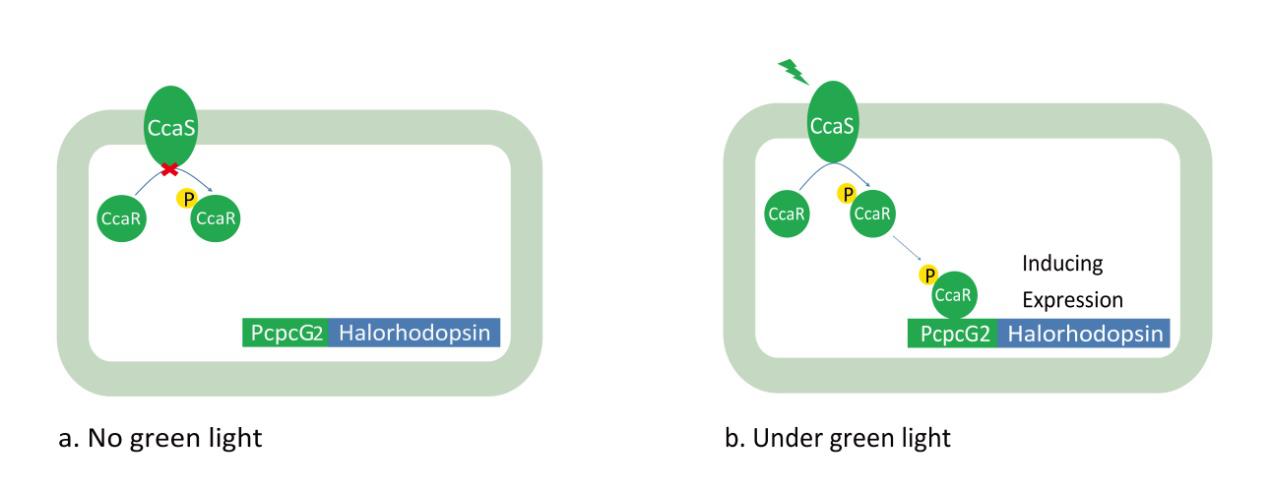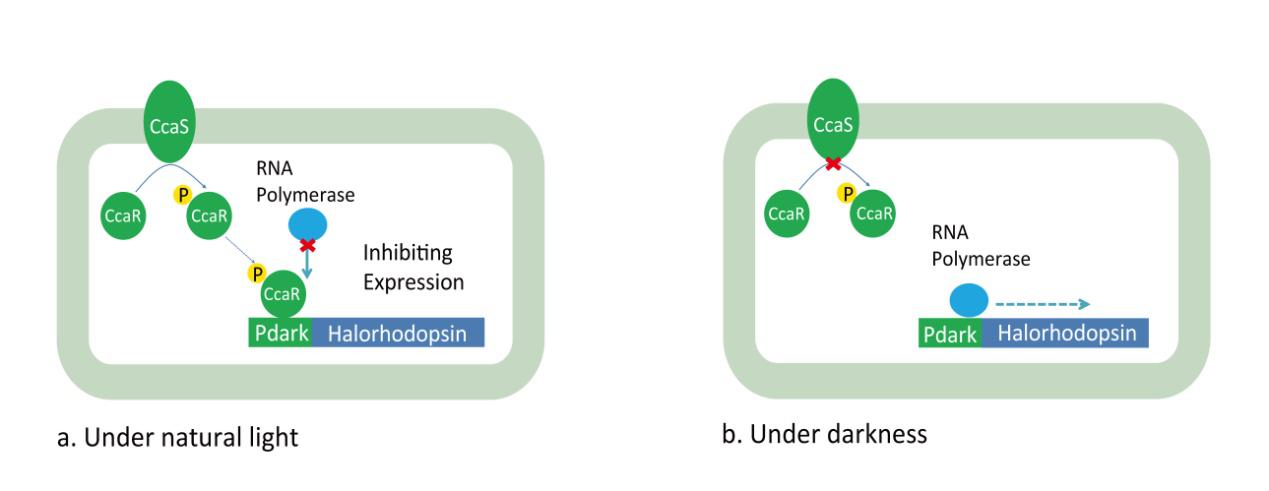Desalination controller
PcpcG2
Light-inducible and heavy metal inducible promoters are the main biological switches in synthetic biology of cyanobacteria. Considering that our ultimate goal is to obtain an engineered organism capable of extracting sodium chloride from seawater without causing any bad effect on the water, candidate promoters should meet a few key criteria. Firstly, the inducing condition shouldn’t leave any harmful substance that is difficult to remove. Secondly, the inducing condition shouldn’t cost too much if applied to industrial scale. Thirdly, the inducing condition should be compatible with starvation. Based on these conditions, we selected two light-inducible promoters which are described in the following paragraphs.
The control of PcpcG2 over downstream gene is based on the CcaS-CcaR-PcpcG2 system identified in Synechosystis sp. strain PCC 6803, which has been well characterized and further engineered to be a useful genetic tool. (Abe, K. et al. 2014) The phycobilisome linker gene cpcG2 is chromatically regulated by the sensor histidine kinase CcaS and cognate response regulater CcaR. CcaS catalyzes autophosphorylation followed by phototransfer to CcaR under green light (Hirose, Y. et al 2010). Phosphorylated CcaR binds to PcpcG2 and induces expression of downstream gene like cpcG2, or halorhodopsin in our recombinant strain. The control mechanism is shown in Figure 1.2.1.
Figure 1.2.1 Control mechanism of PcpcG2..
(a) Without green light, unphosphorylated CcaR can’t bind to PcpcG2 and a significant level of halorhodopsin expression can’t be achieved.
(b) Under green light, phosphorylated CcaR binds to PcpcG2 and induces the expression of halorhodopsin.
Pdark
Red light and green light conditions require artificial illumination or extensive light filter, which may cause difficulties in scaling up biodesalination process. We searched for another promoter that allows the process to rely only on natural light and darkness. And Pdark, which was designed by 2013 iGEM team of our school (BBa_K1026009), was selected. This “dark-sensing” promoter combines PcpcG2 and a constitutive promoter from E.coli and it can be regarded as the “reverse PcpcG2”. Pdark contains a binding site of CcaR in PcpcG2, which overlaps with the binding site of RNA polymerase. Therefore when phosphorylated CcaR binds to it, the binding of RNA polymerase to Pdark will be blocked and transcription can’t be initiated. The control mechanism of Pdark is shown in Figure 1.2.2.
Figure 1.2.2 Control mechanism of Pdark.
(a) Under natural light, the green light component induces phosphorylation of CcaR, and the binding of which to Pdark prevents the binding of RNA polymerase, thus inhibiting expression of halorhodopsin.
(b) Under darkness, RNA Polymerase binds to Pdark as it does in E.coli and initiate the transcription of halorhodopsin.
References
Abe, K., Miyake, K., Nakamura, M., Kojima, K., Ferri, S., Ikebukuro, K., & Sode, K. (2014).Engineering of a green‐light inducible gene expression system in Synechocystis sp. PCC6803. Microbial biotechnology, 7(2), 177-183.
Amezaga, J. M., Amtmann, A., Biggs, C. A., Bond, T., Gandy, C. J., Honsbein, A., & Templeton, M. R. (2014). Biodesalination: a case study for applications of photosynthetic bacteria in water treatment. Plant physiology, 164(4), 1661-1676.
Hirose, Y., Narikawa, R., Katayama, M., & Ikeuchi, M. (2010). Cyanobacteriochrome CcaS regulates phycoerythrin accumulation in Nostoc punctiforme, a group II chromatic adapter. Proceedings of the National Academy of Sciences, 107(19), 8854-8859.
Next: Desalination Driver







